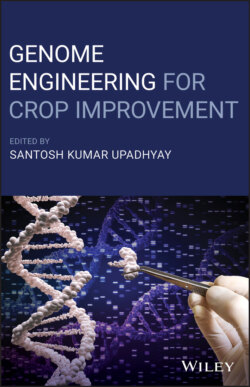Читать книгу Genome Engineering for Crop Improvement - Группа авторов - Страница 29
2.2.1 Matrix Assisted Laser/Desorption/Ionization
ОглавлениеMALDI is mainly used in biomedicine to identify biomarkers associated with various diseases (Grassl et al. 2011), while applications in plant sciences remain limited (Boughton et al. 2016; Dong et al. 2016a). With this technique, large molecules such as proteins can be detected with a lateral resolution of 0 micrometers in novel, state‐of‐the‐art instruments (Römpp and Spengler 2013). The working principle of MALDI is based on the co‐crystallization of the analyte with a chemical matrix which absorbs the laser energy and releases the analyte into the gas phase in a process that leads to ionization (Bjarnholt et al. 2014). The addition of the matrix has a number of advantages: in particular, it enables the ionization of compounds that do not themselves absorb light. Moreover, since the energy of the laser light is absorbed by the matrix and not directly by the analyte, MALDI is a soft ionization technique that exhibits little fragmentation in the mass spectra (Bjarnholt et al. 2014). Unfortunately, when performing MALDI imaging with higher resolution (laser spot sizes smaller than 1 μm), the ion yield (and thus the sensitivity) decreases significantly. Further, the choice of the type of matrix becomes extremely critical, since the size of the matrix crystals incorporated with the analytes should be smaller than the required lateral resolution of the imaging experiment. Also, MALDI is unable to detect metabolites in the low mass range (m/z 1000) due to interference from the high matrix ion background (Bjarnholt et al. 2014).
Recently, workflows were developed for MALDI imaging of plant carbohydrate, lipid, and protein as well as secondary metabolite localization (Dong et al. 2016b; Peukert et al. 2016; Gupta et al. 2019; Lim et al. 2020).
Oligofructans, for example, represent one of the most important groups of sucrose‐derived water–soluble carbohydrates in the plant kingdom. In cereals, oligofructans accumulate in aboveground parts of the plants (stems, leaves, seeds), and their biosynthesis leads to the formation of both types of glycosidic bonds (ß (2,1); ß(2,6)‐fructans) or to mixed patterns. In recent studies, MALDI‐MS imaging has revealed tissue‐ and development‐specific distribution patterns of the different types of oligofructans in barley grains, which may be related to the different phases of grain development, such as cellular differentiation of grain tissue and accumulation of storage products (Peukert et al. 2016).
In the cereal grain, sucrose is converted into storage carbohydrates; mainly starch, fructan, and mixed‐linkage (1,3;1,4)‐β‐glucan(MLG) are formed in ratios, that seem to be tissue‐dependent. Previously, endosperm specific overexpression of the HvCslF6 gene in hull‐less barley led to high MLG and low starch content in mature grains (Lim et al. 2020). Morphological changes included inwardly elongated aleurone cells, irregular cell shapes of the peripheral endosperm and smaller starch granules of the starch‐containing endosperm. Lim et al. (2020) also investigated the physiological basis for these defects by investigating how changes in the carbohydrate composition of the developing grain affect the morphology of mature grains. Visualization of oligosaccharides was performed by MALDI‐MS and complemented by histological studies pointing out the importance of the regulation of carbohydrate distribution for the maintenance of grain‐cell formation and filling processes. Augmented MLG coincided with increased levels of soluble carbohydrates in the cavity and endosperm during the storage phase. Transcript levels of genes related to cell wall, starch, sucrose, and fructan metabolism were disturbed in all tissues. The cell walls of endosperm transfer cells (ETC) in transgenic cereals were thinner and showed reduced mannan labeling compared to the wild type. In the early storage phase, a rupture of the unevenly developed ETC and disorganized neighboring endosperm cells was observed. Soluble sugars accumulated in the developing cereal cave, suggesting a disruption of carbohydrate flow from the cave toward the endosperm, resulted in a shrunken phenotype of the mature grain.
MALDI‐MS imaging was also performed to localize metabolites during the first 7 days of barley germination. Up to 100 mass signals were detected, of which, 85 signals were identified as 48 different metabolites with highly tissue‐specific localizations. Oligosaccharides were observed in the endosperm and in parts of the embryo. Lipids in the endosperm co‐localized, depending on their fatty acid composition, with changes in the distribution of diacyl phosphatidylcholines during germination. Also, 26 potentially antifungal hordatines were detected in the embryo with tissue‐specific localizations of their glycosylated, hydroxylated and O‐methylated derivatives (Gorzolka et al. 2016).
MALDI‐MS also proved to be the technique of choice for studies in plant lipidomics. While profiles of lipids in seed extracts provide detailed measurements of the amounts and types of lipids present, the information about where these lipids are located in the seed is lost with sample preparation and solvent extraction. At present, mass spectrometric imaging allows the detailed identification and localization of lipids and other metabolites in situ, e.g. directly on tissue samples. The application of this technology to oil seeds has shown that lipid metabolites are unevenly distributed in the different tissues of the seed, indicating a spatial complexity of lipid metabolism that was previously unknown (Sturtevant et al. 2018).
